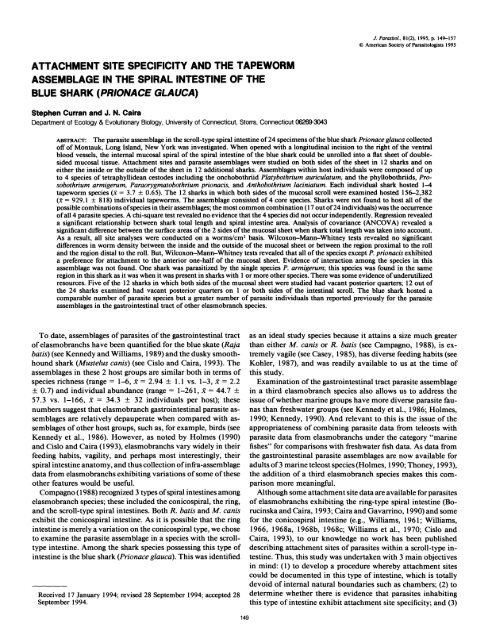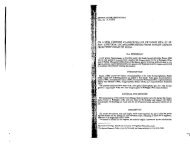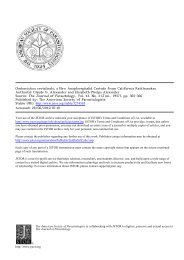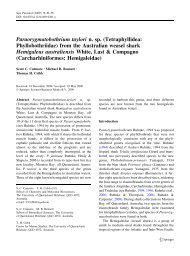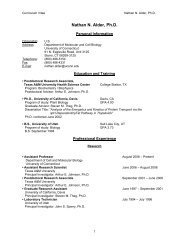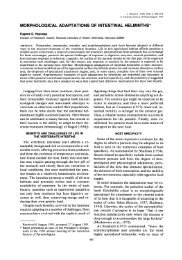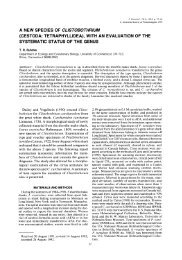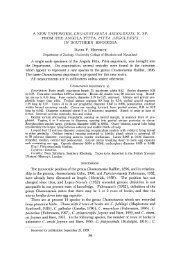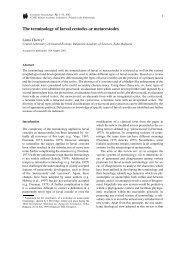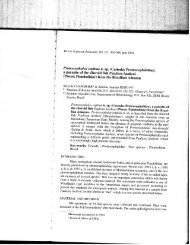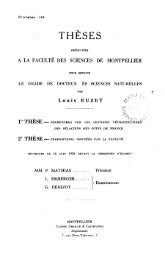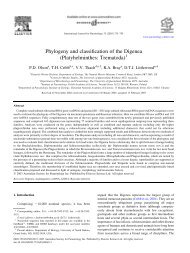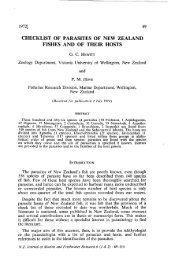Attachment Site Specificity and the Tapeworm Assemblage in the ...
Attachment Site Specificity and the Tapeworm Assemblage in the ...
Attachment Site Specificity and the Tapeworm Assemblage in the ...
You also want an ePaper? Increase the reach of your titles
YUMPU automatically turns print PDFs into web optimized ePapers that Google loves.
150 THE JOURNAL OF PARASITOLOGY, VOL. 81, NO. 2, APRIL 1995to describe <strong>the</strong> parasite assemblage <strong>in</strong> a third elasmobranchspecies, <strong>in</strong> this case, 1 with <strong>the</strong> scroll-type spiral <strong>in</strong>test<strong>in</strong>e.MATERIALS AND METHODSTwenty-four sharks collected us<strong>in</strong>g hook <strong>and</strong> l<strong>in</strong>e by sports fishermenwere necropsied at shark tournaments held <strong>in</strong> Montauk, New York <strong>in</strong><strong>the</strong> summers of 1988, 1990, <strong>and</strong> 1991. These 24 sharks consisted of 20males, rang<strong>in</strong>g <strong>in</strong> total length from 154 cm to 329 cm, <strong>and</strong> 4 females,rang<strong>in</strong>g <strong>in</strong> total length from 199 cm to 211 cm. All sharks had beendead no more than 6 hr <strong>and</strong> no less than 1 hr prior to necropsy. Eachshark was opened with a midventral <strong>in</strong>cision to expose <strong>the</strong> digestivetract. The spiral <strong>in</strong>test<strong>in</strong>e was cut away from <strong>the</strong> rest of <strong>the</strong> digestivetract at <strong>the</strong> pyloric sph<strong>in</strong>cter anteriorly <strong>and</strong> <strong>the</strong> rectum posteriorly <strong>and</strong>placed <strong>in</strong> a dissect<strong>in</strong>g pan. The spiral <strong>in</strong>test<strong>in</strong>e was opened with a longitud<strong>in</strong>al<strong>in</strong>cision through <strong>the</strong> peritoneum <strong>and</strong> <strong>the</strong> underly<strong>in</strong>g mucosathat extended from <strong>the</strong> pyloric sph<strong>in</strong>cter to <strong>the</strong> rectum along <strong>the</strong> ventralsurface of <strong>the</strong> organ to <strong>the</strong> right of <strong>the</strong> largest branch of <strong>the</strong> ventralblood vessel. This allowed <strong>the</strong> <strong>in</strong>test<strong>in</strong>al mucosal spiral to be unrolledas a flat sheet of tissue. The unrolled spiral <strong>in</strong>test<strong>in</strong>es were immediatelysubmerged <strong>in</strong> alcohol-formal<strong>in</strong>-acetic acid (AFA) for 24-48 hr. Theywere <strong>the</strong>n transferred to 70% ethanol for storage until <strong>the</strong> tapewormscould be removed. Only tapeworms rema<strong>in</strong><strong>in</strong>g attached to <strong>the</strong> spiral<strong>in</strong>test<strong>in</strong>e after fixation were <strong>in</strong>cluded <strong>in</strong> this study. As a result, all estimatesof prevalence <strong>and</strong> <strong>in</strong>tensity should be considered to be m<strong>in</strong>imums.To facilitate accurate determ<strong>in</strong>ation of attachment sites, unrolled spi-ral <strong>in</strong>test<strong>in</strong>es were p<strong>in</strong>ned to a large waxed tray <strong>and</strong> submerged <strong>in</strong> 70%ethanol. Each tapeworm was removed <strong>and</strong> its location marked with anickel-plated common p<strong>in</strong> <strong>in</strong> <strong>the</strong> mucosa of <strong>the</strong> <strong>in</strong>test<strong>in</strong>e. A temporarywet mount was prepared of each tapeworm for identification under acompound microscope. As each worm was identified, <strong>the</strong> marker p<strong>in</strong>was replaced by a p<strong>in</strong> color-coded for <strong>the</strong> appropriate tapeworm species.After all worms had been removed from 1 side of <strong>the</strong> mucosal sheet<strong>and</strong> <strong>the</strong>ir positions marked with p<strong>in</strong>s, <strong>the</strong> spiral <strong>in</strong>test<strong>in</strong>e was nailedcompletely flat on a board <strong>and</strong> covered with a pane of glass. The outl<strong>in</strong>eof <strong>the</strong> spiral <strong>in</strong>test<strong>in</strong>e was traced onto a large sheet of transparent plastic<strong>and</strong> <strong>the</strong> attachment sites were transferred onto <strong>the</strong> outl<strong>in</strong>e with penscolor-coded for each tapeworm species. These data were <strong>the</strong>n tracedonto paper us<strong>in</strong>g a light table, <strong>the</strong>reby creat<strong>in</strong>g a real scale map of thatside of <strong>the</strong> mucosal sheet of <strong>the</strong> spiral <strong>in</strong>test<strong>in</strong>e <strong>and</strong> <strong>the</strong> attachment sitesof all tapeworms removed. We were <strong>in</strong>itially concerned that p<strong>in</strong>n<strong>in</strong>g<strong>and</strong> nail<strong>in</strong>g spiral <strong>in</strong>test<strong>in</strong>es to record worm attachment sites for 1 sideof <strong>the</strong> mucosal sheet would damage <strong>the</strong> specimens on <strong>the</strong> o<strong>the</strong>r side,prevent<strong>in</strong>g us from accurately collect<strong>in</strong>g complete data from that side.Thus, only 1 side of <strong>the</strong> mucosal sheet was sampled from <strong>the</strong> spiral<strong>in</strong>test<strong>in</strong>es of <strong>the</strong> first 12 sharks exam<strong>in</strong>ed. However, it became apparentthat, although this procedure often damaged <strong>the</strong> strobila of worms on<strong>the</strong> side of <strong>the</strong> mucosal sheet opposite <strong>the</strong> first side studied, <strong>the</strong> scolicesof <strong>the</strong> worms rema<strong>in</strong>ed attached to that side. This discovery led toattachment site data be<strong>in</strong>g collected from both sides of <strong>the</strong> mucosalsheet <strong>in</strong> <strong>the</strong> last 12 sharks exam<strong>in</strong>ed. Thus, data on attachment siteswere collected from <strong>the</strong> <strong>in</strong>side of <strong>the</strong> scroll <strong>in</strong> 16 sharks total <strong>and</strong> from<strong>the</strong> outside of <strong>the</strong> scroll <strong>in</strong> 20 sharks total.The absence of natural boundaries such as mucosal folds creat<strong>in</strong>gchambers (as are present <strong>in</strong> both <strong>the</strong> r<strong>in</strong>g- <strong>and</strong> conicospiral-type <strong>in</strong>test<strong>in</strong>es)required <strong>the</strong> establishment of study zones for analysis of sitespecificity <strong>in</strong> <strong>the</strong> scroll-type <strong>in</strong>test<strong>in</strong>e. Thus, each spiral <strong>in</strong>test<strong>in</strong>e trac<strong>in</strong>gwas divided <strong>in</strong>to quarters by establish<strong>in</strong>g horizontal <strong>and</strong> vertical midl<strong>in</strong>esus<strong>in</strong>g length <strong>and</strong> width measurements of <strong>the</strong> complete unrolledspiral <strong>in</strong>test<strong>in</strong>e. We use <strong>the</strong> follow<strong>in</strong>g term<strong>in</strong>ology to refer to <strong>the</strong> variousregions of <strong>the</strong> unrolled mucosal sheet. This term<strong>in</strong>ology applies only tospiral <strong>in</strong>test<strong>in</strong>es opened with <strong>in</strong>cisions placed exactly as described above.The <strong>in</strong>side of <strong>the</strong> scroll or mucosal sheet is <strong>the</strong> side primarily illustrated<strong>in</strong> Figure 1. The outside of <strong>the</strong> scroll or mucosal sheet is <strong>the</strong> side opposite<strong>the</strong> <strong>in</strong>side; when <strong>the</strong> mucosal sheet is unrolled <strong>and</strong> laid flat to expose<strong>the</strong> <strong>in</strong>side of <strong>the</strong> roll, <strong>the</strong> outside of <strong>the</strong> roll is hidden from view. Eachside of <strong>the</strong> unrolled mucosal sheet can be divided <strong>in</strong>to anterior <strong>and</strong>posterior halves with a horizontal l<strong>in</strong>e runn<strong>in</strong>g across <strong>the</strong> center of <strong>the</strong>sheet. The anterior half of <strong>the</strong> <strong>in</strong>test<strong>in</strong>e refers to <strong>the</strong> anterior region ofboth <strong>the</strong> <strong>in</strong>side <strong>and</strong> outside surfaces of <strong>the</strong> mucosal sheet. The posteriorhalf of <strong>the</strong> <strong>in</strong>test<strong>in</strong>e refers to <strong>the</strong> posterior region of both <strong>the</strong> <strong>in</strong>side <strong>and</strong>outside surfaces of <strong>the</strong> mucosal sheet. The unrolled mucosal sheet canbe divided <strong>in</strong>to left <strong>and</strong> right halves with a vertical l<strong>in</strong>e parallel to <strong>the</strong>longitud<strong>in</strong>al axis of <strong>the</strong> <strong>in</strong>test<strong>in</strong>e. In nam<strong>in</strong>g <strong>the</strong>se halves, we wanted touse <strong>the</strong> same term<strong>in</strong>ology for homologous regions regardless of whe<strong>the</strong>rwe were referr<strong>in</strong>g to <strong>the</strong> <strong>in</strong>side or <strong>the</strong> outside surface of <strong>the</strong> mucosalsheet (thus left <strong>and</strong> right are <strong>in</strong>appropriate). Because <strong>the</strong> sheet rolls from1 side only, we have chosen to refer to <strong>the</strong>se 2 areas as proximal to <strong>the</strong>roll (this is <strong>the</strong> region that rolls first, so it is <strong>the</strong> right half on <strong>the</strong> <strong>in</strong>sidesurface <strong>and</strong> <strong>the</strong> left half on <strong>the</strong> outside surface) <strong>and</strong> distal to <strong>the</strong> roll(this is <strong>the</strong> last region of <strong>the</strong> sheet to roll, so it is <strong>the</strong> left half on <strong>the</strong><strong>in</strong>side surface <strong>and</strong> <strong>the</strong> right half on <strong>the</strong> outside surface).To make it possible to control for differences <strong>in</strong> surface area amongregions be<strong>in</strong>g compared for tapeworms, <strong>in</strong> case larger areas have moreworms than smaller areas, <strong>the</strong> trac<strong>in</strong>gs of each of <strong>the</strong> 4 regions fromeach surface (<strong>in</strong>side <strong>and</strong> outside <strong>the</strong> roll) for each shark were scannedwith a Datacopy 730GS desktop scanner <strong>and</strong> <strong>the</strong> area of each trac<strong>in</strong>gwas calculated accord<strong>in</strong>g to <strong>the</strong> procedure given by Cislo <strong>and</strong> Caira(1993). The lateral peritoneal strip (present only on <strong>the</strong> <strong>in</strong>side of <strong>the</strong>roll) was excluded from area calculations because it is <strong>the</strong> external surfaceof <strong>the</strong> organ, does not possess a mucosal surface, <strong>and</strong> as a consequencedoes not represent potential attachment sites for tapeworms. Allmeans are given followed by st<strong>and</strong>ard deviation.Statistical analysis systems (SAS) was used to perform all statisticalprocedures. Spiral <strong>in</strong>test<strong>in</strong>e mucosal area was regressed on shark length<strong>in</strong> <strong>the</strong> 12 sharks <strong>in</strong> which both sides of <strong>the</strong> mucosa were exam<strong>in</strong>ed totest for a relationship between shark size <strong>and</strong> spiral <strong>in</strong>test<strong>in</strong>e area. Todeterm<strong>in</strong>e whe<strong>the</strong>r <strong>the</strong>re was a difference <strong>in</strong> area between <strong>the</strong> <strong>in</strong>side <strong>and</strong><strong>the</strong> outside of <strong>the</strong> mucosal scroll, an analysis of covariance (ANCOVA)was conducted compar<strong>in</strong>g <strong>the</strong> surface areas between <strong>the</strong> 2 sides <strong>in</strong> <strong>the</strong>12 sharks <strong>in</strong> which both sides of <strong>the</strong> spiral <strong>in</strong>test<strong>in</strong>e were analyzed. Ifa significant difference was found, to st<strong>and</strong>ardize for surface area, <strong>the</strong>number of <strong>in</strong>dividuals of each cestode species <strong>in</strong> each of <strong>the</strong> comparisonsmade, was divided by <strong>the</strong> area of <strong>the</strong> correspond<strong>in</strong>g region so that allcomparisons were made on a worm per cm2 (worm density) basis. Prelim<strong>in</strong>aryexam<strong>in</strong>ation of <strong>the</strong> worm density data <strong>in</strong>dicated that it wasnot normal <strong>in</strong> distribution, thus nonparametric tests were used for analysisof all worm density data. A Wilcoxon-Mann-Whitney test wasperformed on <strong>the</strong> density of each tapeworm species <strong>in</strong> <strong>the</strong> 12 <strong>in</strong>dividuals<strong>in</strong> which both sides of <strong>the</strong> mucosal surface of <strong>the</strong> <strong>in</strong>test<strong>in</strong>e were sampledto determ<strong>in</strong>e whe<strong>the</strong>r <strong>the</strong>re was a difference <strong>in</strong> number of <strong>in</strong>dividualsof any of <strong>the</strong> cestode species between <strong>the</strong> <strong>in</strong>side <strong>and</strong> <strong>the</strong> outside of <strong>the</strong><strong>in</strong>test<strong>in</strong>al scroll. The results of <strong>the</strong>se analyses were used to determ<strong>in</strong>ewhe<strong>the</strong>r <strong>the</strong> data from <strong>the</strong> 2 sides of <strong>the</strong> <strong>in</strong>test<strong>in</strong>al scroll could be comb<strong>in</strong>edfor <strong>the</strong> analyses of anterior versus posterior <strong>and</strong> proximal to rollversus distal to roll. <strong>Site</strong> specificity was addressed by conduct<strong>in</strong>g 3Wilcoxon-Mann-Whitney tests for each cestode species, compar<strong>in</strong>g distributionof tapeworm <strong>in</strong>dividuals <strong>in</strong> all 24 sharks sampled st<strong>and</strong>ardizedfor surface area: (1) between <strong>the</strong> <strong>in</strong>side <strong>and</strong> <strong>the</strong> outside surfaces of <strong>the</strong>mucosal sheet, (2) between <strong>the</strong> anterior <strong>and</strong> posterior halves of <strong>the</strong>mucosal sheet, <strong>and</strong> (3) between <strong>the</strong> halves of <strong>the</strong> mucosal sheet proximalto <strong>the</strong> roll <strong>and</strong> distal to <strong>the</strong> roll. Species present <strong>in</strong> 60% or more host<strong>in</strong>dividuals were considered to be core species. For analysis of vacantspace, a f<strong>in</strong>er scale was created by subdivid<strong>in</strong>g each of <strong>the</strong> anterior <strong>and</strong>posterior halves <strong>in</strong> half with horizontal l<strong>in</strong>es, <strong>the</strong>reby establish<strong>in</strong>g 8regions for exam<strong>in</strong>ation.A chi-square test was performed to exam<strong>in</strong>e whe<strong>the</strong>r <strong>the</strong> parasitespecies were <strong>in</strong>dependently distributed among host <strong>in</strong>dividuals. Thenumber of observed occurrences of each possible comb<strong>in</strong>ation of <strong>the</strong> 4parasite species was compared to <strong>the</strong> number of expected occurrences.The probability of a species occurr<strong>in</strong>g <strong>in</strong> a shark was assumed to beequivalent to its observed overall prevalence. We estimated <strong>the</strong> prob-ability of a species not occurr<strong>in</strong>g <strong>in</strong> a shark as 1 m<strong>in</strong>us <strong>the</strong> observedoverall prevalence for that species. Expected values for <strong>the</strong> chi-squaretest were generated by multiply<strong>in</strong>g <strong>the</strong> sample size by <strong>the</strong> probabilityof a comb<strong>in</strong>ation occurr<strong>in</strong>g.For visual <strong>in</strong>spection, <strong>the</strong> attachment sites of all <strong>in</strong>dividuals of eachtapeworm species found <strong>in</strong> <strong>the</strong> 24 sharks were st<strong>and</strong>ardized by divid<strong>in</strong>g<strong>the</strong> area of each spiral <strong>in</strong>test<strong>in</strong>e trac<strong>in</strong>g (<strong>in</strong>side <strong>and</strong> outside) <strong>in</strong>to a 32by 32 square grid (peritoneal area was <strong>in</strong>cluded <strong>in</strong> <strong>the</strong> grid of <strong>in</strong>sidearea) <strong>and</strong> <strong>the</strong>n plott<strong>in</strong>g <strong>the</strong> location of all tapeworms found on this grid.<strong>Attachment</strong> site data were comb<strong>in</strong>ed from <strong>the</strong> 16 sharks <strong>in</strong> which <strong>the</strong><strong>in</strong>side of <strong>the</strong> mucosal sheet was exam<strong>in</strong>ed <strong>and</strong> were comb<strong>in</strong>ed for <strong>the</strong>20 sharks <strong>in</strong> which <strong>the</strong> outside of <strong>the</strong> mucosal sheet was exam<strong>in</strong>ed.
CURRAN AND CAIRA-INTESTINAL PARASITES OF P. GLAUCA 151peritoneum i1.._r'-.mucosalc ov e,,sheto pyloric stomachouter muscular layer <strong>and</strong> ..... ..: ~~<strong>in</strong>sideperitoneum cover,,,~ :ofi... ?!:::!:.:. :~"....uo;al sheetIi!/!~i~~",~ :"-:~~i:'!i:.:.':'. -.....::.:...: '-:.'-~.: .;-,'.,:i=.-:'.'-." .: m,.: i/":4::i i. . .'..outside ofmucosal sheet~~~~~~. ::i~.:.:.-?~'..~~~'.'.;.... :.. . ' . : !..:~:~ ~ ~ ~ '~.-.. ..; ~... '.. ~~~~~~~~~~~~~~i!.-I.. .::'.:.,~,~. .~ .::.:z: i!i:i- :.:.1.-- . " ~::!?~?..- '4 ~~..p o s t e rio.' ?.. ? - .. ...:.. :,!".'.:.'. ';i: ~.';;.~-? !i":;i-:-?"':!.?:.;.;'',~'-:-....'.'~.?~-?:~.:.';'~.;;:;": '': :,...~.. ::. ':.O.' : ':i:.?.:~~~~~~~~~~~~~~~~~...-. , ~~~~~~~~~~~~~~~~~~~:'.....;$!~ . :.:.. ,:~ii:i.', :' ,...'ii ";~'.~.. :.::.i!: '1;?.-: ,~~~~~~~~~~~~~~~~~~~~~~?..?.:~...~~~~~~~~~~~~~~~~~~~~~~~~~~~~~~~~~~~~~~~~~~~~~'.:;-'.-,t:,':.:-i~'?~-- '~?"?~,.." ... . ... ,-- ,,,, ----~.. ',:'!?"Z '";~ I-.. . -:~... ..~.... . . . 1 . .....I.'..., ...., , ,~~~~~1. :'... ...., ...~- ", ,--.:.- -.-- - '.......Ihalf i s da l , half p r o x i m a l -.. . :- . ,.. I ,:.Ii.to t , roll- ,; " o . i4, ...! . - ~~~~, I"' '- 1 , :...!... - .1~t rectum ..FIGURE 1. Internal anatomy of <strong>the</strong> spiral <strong>in</strong>test<strong>in</strong>e of Prionace glauca.
152 THE JOURNAL OF PARASITOLOGY, VOL. 81, NO. 2, APRIL 1995Three-dimensional graphs of <strong>the</strong> distribution of <strong>the</strong> <strong>in</strong>dividuals of eachparasite species on each side of <strong>the</strong> mucosal sheet were created from<strong>the</strong>se data us<strong>in</strong>g <strong>the</strong> program SigmaPlot (Figs. 3-10).Four voucher specimens of each parasite species were deposited at<strong>the</strong> H. W. Manter Laboratory, University of Nebraska State Museum(HWML numbers: Platybothrium auriculatum Yamaguti, 1952, 37549;Paraorygmatobothrium prionacis (Yamaguti, 1952) Ruhnke, 1993,37548; Prosobothrium armigerum Cohn, 1902, 37550; Anthobothriumlac<strong>in</strong>iatum L<strong>in</strong>ton, 1890, 37547).RESULTSThe spiral <strong>in</strong>test<strong>in</strong>eThe scroll <strong>in</strong>test<strong>in</strong>e of <strong>the</strong> blue shark consists of a tube conta<strong>in</strong><strong>in</strong>ga double-sided sheet of absorptive mucosa rolled arounda longitud<strong>in</strong>al axis like a parchment scroll (Fig. 1). The dissect<strong>in</strong>gprotocol described above resulted <strong>in</strong> <strong>the</strong> outer peritoneal tubeor cover<strong>in</strong>g of <strong>the</strong> <strong>in</strong>test<strong>in</strong>e be<strong>in</strong>g oriented as a strip along <strong>the</strong>left of <strong>the</strong> opened <strong>in</strong>test<strong>in</strong>e when <strong>the</strong> unrolled mucosal sheet islaid open <strong>and</strong> <strong>the</strong> surface of <strong>the</strong> mucosal sheet that represents<strong>the</strong> <strong>in</strong>side of <strong>the</strong> scroll is oriented upward (Fig. 1). We foundthat it was critical to consistently cut <strong>the</strong> <strong>in</strong>test<strong>in</strong>e to <strong>the</strong> rightof <strong>the</strong> ventral blood vessels <strong>in</strong> order to achieve this orientation.Because <strong>the</strong> mucosal sheet is essentially a spiral of tissue, a cutalong any l<strong>in</strong>e except <strong>the</strong> region to <strong>the</strong> right of <strong>the</strong> ventral bloodvessels results <strong>in</strong> a different orientation of <strong>the</strong> mucosal tissue.For example, a cut on <strong>the</strong> dorsal side of <strong>the</strong> <strong>in</strong>test<strong>in</strong>e adjacentto <strong>the</strong> mesentery that suspends <strong>the</strong> organ from <strong>the</strong> roof of <strong>the</strong>body cavity results <strong>in</strong> <strong>the</strong> peritoneal strip be<strong>in</strong>g found on <strong>the</strong>outside ra<strong>the</strong>r than <strong>the</strong> <strong>in</strong>side of <strong>the</strong> mucosal sheet.The total spiral <strong>in</strong>test<strong>in</strong>e area <strong>in</strong> <strong>the</strong> 12 sharks <strong>in</strong> which areawas calculated for both sides of <strong>the</strong> <strong>in</strong>test<strong>in</strong>al scroll ranged from2,822.6 cm2 <strong>in</strong> a shark with a total length of 154 cm, to 6,797.5cm2 <strong>in</strong> a shark with a total length of 320 cm. The regression ofshark length on spiral <strong>in</strong>test<strong>in</strong>e area was significant (P = 0.01,F= 10.0). ANCOVA revealed a significant difference (P = 0.0001;F = 44.4; df = 2) between <strong>the</strong> areas of <strong>the</strong> <strong>in</strong>side <strong>and</strong> <strong>the</strong> outsideof <strong>the</strong> mucosal scrolls <strong>in</strong> <strong>the</strong>se 12 <strong>in</strong>dividuals when total sharklength was taken <strong>in</strong>to consideration. This difference <strong>in</strong> area resulted<strong>in</strong> all subsequent comparisons be<strong>in</strong>g made on a worm/cm2 basis so that data from both sides of <strong>the</strong> <strong>in</strong>test<strong>in</strong>e could becomb<strong>in</strong>ed for tests of anterior versus posterior attachment sites<strong>and</strong> proximal to <strong>the</strong> roll versus distal to <strong>the</strong> roll attachmentsites.The parasite assemblageThe parasite assemblage <strong>in</strong> <strong>the</strong> spiral <strong>in</strong>test<strong>in</strong>e of P. glaucaconsisted entirely of tetraphyllidean tapeworms. Four specieswere found. These <strong>in</strong>cluded <strong>the</strong> onchobothriid P. auriculatum,<strong>and</strong> <strong>the</strong> phyllobothriids, P. prionacis, A. lac<strong>in</strong>iatum, <strong>and</strong> P. armigerum.In <strong>the</strong> 12 sharks <strong>in</strong> which both sides of <strong>the</strong> <strong>in</strong>test<strong>in</strong>al0 1 2 3 4Number of tapeworm species per sharkFIGURE 2. Number of cestode species per shark <strong>in</strong> 24 <strong>in</strong>dividualsof P. glauca.mucosal scroll were exam<strong>in</strong>ed, all of <strong>the</strong> species present werefound on both sides. This suggested that data from sharks <strong>in</strong>which only 1 side of <strong>the</strong> mucosal flap was exam<strong>in</strong>ed reflectedspecies present on <strong>the</strong> o<strong>the</strong>r side as well <strong>and</strong> thus that prevalence<strong>and</strong> assemblage composition data could be <strong>in</strong>ferred from 1 sideof <strong>the</strong> mucosa to <strong>the</strong> shark <strong>in</strong> general. However, we did not feeljustified <strong>in</strong> <strong>in</strong>ferr<strong>in</strong>g <strong>in</strong>tensity data from 1 side of <strong>the</strong> mucosalsheet to <strong>the</strong> shark <strong>in</strong> general. Individual sharks conta<strong>in</strong>ed 2-4(x = 3.7 ? 0.65) tapeworm species <strong>in</strong> <strong>the</strong> 12 sharks <strong>in</strong> whichboth sides of <strong>the</strong> mucosal sheet were exam<strong>in</strong>ed <strong>and</strong> 1-4 (x =3.6 ? 0.77) <strong>in</strong> all 24 sharks, if it is assumed each side is representativeof a shark. The most common number of parasitespecies per shark was 4 (Fig. 2). The mean number of tapeworm<strong>in</strong>dividuals per shark for <strong>the</strong> 12 sharks <strong>in</strong> which both sides of<strong>the</strong> mucosal sheet were exam<strong>in</strong>ed was 941 ? 807, with a rangeof 156-2,382 tapeworms per shark. Of <strong>the</strong> 11,304 worms found<strong>in</strong> <strong>the</strong>se 12 sharks, 3.9% were P. armigerum, 21.2% were A.lac<strong>in</strong>iatum, 43.6% were P. auriculatum, <strong>and</strong> 31.3% were P.prionacis. Prevalence <strong>and</strong> mean <strong>in</strong>tensity data for <strong>the</strong> 4 tapewormspecies <strong>in</strong> <strong>the</strong> 12 sharks <strong>in</strong> which both sides of <strong>the</strong> <strong>in</strong>test<strong>in</strong>ewere studied are given <strong>in</strong> Table I. Although prevalences werevery similar among all 4 species, vary<strong>in</strong>g only from 83.3% <strong>in</strong>P. prionacis to 100% <strong>in</strong> P. auriculatum, mean <strong>in</strong>tensities rangedfrom 39.3 P. armigerum to 400.8 P. auriculatum per <strong>in</strong>dividualTABLE I. Spiral <strong>in</strong>test<strong>in</strong>e cestodes <strong>in</strong> 12 sharks <strong>in</strong> which both sides of <strong>the</strong> mucosal scroll were exam<strong>in</strong>ed.No. sharks Prevalence Mean <strong>in</strong>tensity<strong>Tapeworm</strong> species <strong>in</strong>fected (%) (?SD) RangePlatybothrium auriculatum 12 100 400.8 ? 555.7 19-928Paraorygmatobothrium prionacis 10 83.3 353.5 + 494.3 7-1,644Anthobothrium lac<strong>in</strong>iatum 11 91.6 215.6 ? 213.9 7-605Prosobothrium armigerum 11 91.6 39.3 ? 36.2 2-96
CURRAN AND CAIRA-INTESTINAL PARASITES OF P. GLAUCA 153TABLE II. Spiral <strong>in</strong>test<strong>in</strong>e cestodes <strong>in</strong> blue sharks (Prionace glauca) <strong>in</strong> which only 1 side of <strong>the</strong> mucosal scroll was exam<strong>in</strong>ed.Inside of mucosal scroll*Outside of mucosal scrolltNo. Preva- Mean No. Preva- Meansharks lence <strong>in</strong>tensity sharks lence <strong>in</strong>tensity<strong>Tapeworm</strong> species <strong>in</strong>fected (%) (+SD) Range <strong>in</strong>fected (%) (+SD) RangePlatybothrium auriculatum 3 75 71.3 + 58 29-138 8 100 116.4 + 193.6 6-581Paraorygmatobothrium prionacis 2 50 17.5 ? 2 16-19 8 100 74.5 + 84.9 15-270Anthobothrium lac<strong>in</strong>iatum 3 75 45.0 ? 52 14-105 7 87.5 119.6 + 80.3 20-219Prosobothrium armigerum 4 100 22.5 ? 18 2-45 7 87.5 10.3 ? 12.9 1-38* From a total of 4 sharks.t From a total of 8 sharks.shark. Prevalence <strong>and</strong> mean <strong>in</strong>tensity data for <strong>the</strong> tapeworms<strong>in</strong> <strong>the</strong> 4 sharks <strong>in</strong> which only <strong>the</strong> <strong>in</strong>side of <strong>the</strong> mucosal scrollwas exam<strong>in</strong>ed <strong>and</strong> <strong>in</strong> <strong>the</strong> 8 sharks <strong>in</strong> which only <strong>the</strong> outside of<strong>the</strong> mucosal scroll was exam<strong>in</strong>ed are given <strong>in</strong> Table II.Not all of <strong>the</strong> possible comb<strong>in</strong>ations of <strong>the</strong> 4 parasite specieswere encountered. For example, of <strong>the</strong> 6 possible 2-species comb<strong>in</strong>ationsonly 1 comb<strong>in</strong>ation, P. auriculatum <strong>and</strong> P. prionacis,was encountered. Only 1 out of 24 sharks exam<strong>in</strong>ed had a monospecific<strong>in</strong>fection; P. armigerum was found alone once. Basedon <strong>the</strong> data from all 24 sharks, all 4 species should be consideredcore species; even though only 1 side of <strong>the</strong> <strong>in</strong>test<strong>in</strong>al scroll wasexam<strong>in</strong>ed <strong>in</strong> 12 of <strong>the</strong>se <strong>in</strong>dividuals, all 4 species were found<strong>in</strong> over 65% of <strong>the</strong> 24 shark <strong>in</strong>dividuals exam<strong>in</strong>ed. The resultsof <strong>the</strong> chi-square test for <strong>in</strong>dependence of occurrence of <strong>the</strong> 4species are given <strong>in</strong> Table III. No significant difference wasdetected between <strong>the</strong> observed frequencies of occurrence ofcomb<strong>in</strong>ations of species <strong>and</strong> <strong>the</strong> expected values.The comb<strong>in</strong>ed distributions of all of <strong>the</strong> <strong>in</strong>dividuals of eachof <strong>the</strong> 4 species on each side of <strong>the</strong> spiral <strong>in</strong>test<strong>in</strong>e are shown<strong>in</strong> Figures 3-10. The results of <strong>the</strong> statistical analyses for sitespecificity are summarized <strong>in</strong> Table IV. No significant differenceswere found with <strong>the</strong> Wilcoxon-Mann-Whitney tests forany of <strong>the</strong> 4 tapeworm species between <strong>the</strong> <strong>in</strong>side <strong>and</strong> outsideof <strong>the</strong> mucosal sheet or between <strong>the</strong> halves proximal <strong>and</strong> distalto <strong>the</strong> roll. However, P. auriculatum, P. armigerum, <strong>and</strong>, to alesser extent, A. lac<strong>in</strong>iatum, were all found <strong>in</strong> significantly greaternumbers <strong>in</strong> <strong>the</strong> anterior half of <strong>the</strong> <strong>in</strong>test<strong>in</strong>e than <strong>in</strong> <strong>the</strong>posterior half of <strong>the</strong> <strong>in</strong>test<strong>in</strong>e. There appeared to be no difference<strong>in</strong> <strong>the</strong> distribution of P. prionacis between <strong>the</strong> anterior <strong>and</strong>posterior halves of <strong>the</strong> mucosal sheet.The distribution of vacant regions of <strong>the</strong> mucosal scroll <strong>in</strong><strong>the</strong> 24 sharks exam<strong>in</strong>ed is summarized for <strong>the</strong> <strong>in</strong>side of <strong>the</strong>mucosal sheet <strong>in</strong> Figure 11 <strong>and</strong> for <strong>the</strong> outside of <strong>the</strong> mucosalsheet <strong>in</strong> Figure 12. As a result of <strong>the</strong> additional horizontal subdivisionof <strong>the</strong> 4 primary regions, <strong>the</strong> regions numbered 1-8are: anteriormost quarter, regions 1 <strong>and</strong> 2; anterior middle quarter,regions 3 <strong>and</strong> 4; posterior middle quarter, regions 5 <strong>and</strong> 6;<strong>and</strong> posterior quarter, regions 7 <strong>and</strong> 8. The posterior quarterwas most commonly vacant; this region was vacant on <strong>the</strong> <strong>in</strong>sideof <strong>the</strong> mucosal sheet <strong>in</strong> 56.3% of <strong>the</strong> sharks <strong>and</strong> on <strong>the</strong> outsideof <strong>the</strong> mucosal sheet <strong>in</strong> 45% of <strong>the</strong> sharks.DISCUSSIONThe attachment site specificity of tapeworms <strong>in</strong> P. glauca wassimilar to site specificity of tapeworms <strong>in</strong> M. canis (see Cislo<strong>and</strong> Caira, 1993) <strong>in</strong> that 3 of <strong>the</strong> 4 tapeworm species presentshowed a preference for attachment to <strong>the</strong> anterior region of <strong>the</strong>spiral <strong>in</strong>test<strong>in</strong>e. Prosobothrium armigerum was <strong>the</strong> most sitespecific as it was found only rarely <strong>in</strong> <strong>the</strong> posterior two-thirdsof <strong>the</strong> spiral <strong>in</strong>test<strong>in</strong>e (see Figs. 6, 10). None of <strong>the</strong> tapewormsof <strong>the</strong> blue shark showed <strong>the</strong> high degree of site specificity thatCislo <strong>and</strong> Caira (1993) found for Prochristianella tumidula (L<strong>in</strong>ton,1890) Campbell <strong>and</strong> Carvajal, 1975 <strong>and</strong> Calliobothriuml<strong>in</strong>toni Euzet, 1954 <strong>in</strong> <strong>the</strong> dusky smooth-hound shark.Consistent with <strong>the</strong> results of previous studies of o<strong>the</strong>r vertebratehosts e.g., Stock <strong>and</strong> Holmes (1988), Holmes (1990),<strong>and</strong> Cislo <strong>and</strong> Caira (1993), <strong>the</strong> posterior region was <strong>the</strong> mostcommonly vacant region <strong>in</strong> <strong>the</strong> <strong>in</strong>test<strong>in</strong>e of <strong>the</strong> blue shark. Thefact that <strong>in</strong>dividuals of A. lac<strong>in</strong>iatum <strong>and</strong> P. auriculatum wereoccasionally found <strong>in</strong> <strong>the</strong> posterior of <strong>the</strong> <strong>in</strong>test<strong>in</strong>e despite <strong>the</strong>irmuch more common presence <strong>in</strong> <strong>the</strong> anterior of <strong>the</strong> <strong>in</strong>test<strong>in</strong>esuggests that <strong>the</strong> posterior region may represent an area of underutilizedresources for <strong>the</strong>se species. But, as P. armigerum wasTABLE III. Chi-square comparison of observed frequency distributionof cestode species occurrences <strong>in</strong> 24 <strong>in</strong>dividuals of Prionace glauca toexpected distributions.Parasite Observed Expectedspecies number numberassemblage* of sharks of sharks x2None 0 0 01 1 0 02 0 0.03 0.033 0 0 04 0 0 01, 2 0 0.31 0.311,3 0 0 01,4 0 0 02, 3 1 0.14 5.282, 4 0 0.31 0.313,4 0 0 01,2,3 1 1.54 0.191,2,4 4 3.36 0.122,3,4 1 1.54 0.191,3,4 0 0 01, 2, 3, 4 16 16.77 0.04XX2total = 6.5= 25* 1, Prosobothrium armigerum; 2, Platybothrium auriculatum; 3, Paraorygmatobothriumprionacis; 4, Anthobothrium lac<strong>in</strong>iatum.critical
'A154 THE JOURNAL OF PARASITOLOGY, VOL. 81, NO. 2, APRIL 1995I0:s37Distance from peritoneal edgeDistance from roll edgeo0 &n;I1.?2:EWIIziDistance from peritoneal edge4Distance from roll edge8or:?zDistance from peritoneal edge59E30?.SX4Z%\11. Is 15I 20I 25i^ 3010Distance from peritoneal edgeDistance from roll edge
CURRAN AND CAIRA-INTESTINAL PARASITES OF P. GLAUCA 155TABLE IV. Results of Wilcoxon-Mann-Whitney tests for site specificityof tapeworms <strong>in</strong> 24 <strong>in</strong>dividuals of Prionace glauca.*P valuesProximalInside to roll Anteriorvs. vs. distal vs.Parasite species outside to rollt posteriort;->0Ifirllix)75-11Platybothrium auriculatum 0.2862 0.6133 0.0001IParaorygmatobothrium prionacis 0.8605 0.8684 0.2948Anthobothrium lac<strong>in</strong>iatum 0.7866 0.1897 0.0012tProsobothrium armigerum 0.1225 0.2342 0.0001-450-* All tests performed on worms per cm2.t Data from <strong>in</strong>side <strong>and</strong> outside surfaces comb<strong>in</strong>ed.t Significant at P = 0.01 level.I-CO25-essentially never found <strong>in</strong> <strong>the</strong> posterior of <strong>the</strong> <strong>in</strong>test<strong>in</strong>e, it is notclear that this region is underutilized with respect to this parasitespecies (see Holmes, 1973). The predom<strong>in</strong>ance of anterior attachmentsites among parasites with<strong>in</strong> <strong>the</strong> gastro<strong>in</strong>test<strong>in</strong>al tractof vertebrates may at least partially be expla<strong>in</strong>ed by <strong>the</strong> fact thatfood enters all types of <strong>in</strong>test<strong>in</strong>es from <strong>the</strong> anterior <strong>and</strong> passestoward <strong>the</strong> posterior. Thus, nutrients available to parasites <strong>in</strong><strong>the</strong> posterior of <strong>the</strong> <strong>in</strong>test<strong>in</strong>e are likely to be very different fromthose <strong>in</strong> <strong>the</strong> anterior <strong>and</strong> are generally likely to be found <strong>in</strong> muchshorter supply <strong>in</strong> <strong>the</strong> posterior than <strong>in</strong> <strong>the</strong> anterior.Only 1 of <strong>the</strong> 24 blue sharks exam<strong>in</strong>ed hosted a s<strong>in</strong>gle speciesof parasite (P. armigerum) <strong>in</strong> its spiral <strong>in</strong>test<strong>in</strong>e. In this shark,<strong>in</strong>dividuals of P. armigerum were restricted to <strong>the</strong> anterior regionof <strong>the</strong> spiral <strong>in</strong>test<strong>in</strong>e, just as <strong>the</strong>y were <strong>in</strong> sharks withmultiple species <strong>in</strong>fections. Despite this result, we feel that additionaldata from monospecific <strong>in</strong>fections are required before<strong>the</strong> issue of whe<strong>the</strong>r <strong>the</strong> assemblage is <strong>in</strong>teractive can be addressed.The composition of <strong>the</strong> gastro<strong>in</strong>test<strong>in</strong>al parasite assemblage<strong>in</strong> <strong>the</strong> blue shark was strik<strong>in</strong>gly similar to <strong>the</strong> assemblages describedfor <strong>the</strong> 2 o<strong>the</strong>r elasmobranch species whose assemblageshave been numerically characterized (Kennedy <strong>and</strong> Williams,1989; Cislo <strong>and</strong> Caira, 1993), <strong>in</strong> that it consisted entirely, or atleast predom<strong>in</strong>ately, of cestodes, all of which are relatively hostspecific. We believe that all 4 cestode species <strong>in</strong> <strong>the</strong> spiral <strong>in</strong>test<strong>in</strong>eof P. glauca are specialists. To date, P. auriculatum <strong>and</strong>A. lac<strong>in</strong>iatum are known only from <strong>the</strong> blue shark. The taxonomicstatus of P. prionacis affects our <strong>in</strong>terpretation of its hostdistribution. Euzet's (1959) recognition of this species as a synonymof Crossobothrium angustum (L<strong>in</strong>ton, 1889) extended itshost range to <strong>the</strong> thresher shark Alopias vulp<strong>in</strong>us, but this synonymywas rejected by Ruhnke (1993) <strong>in</strong> his recent treatmentof <strong>the</strong> group. Present host records for P. armigerum <strong>in</strong>dicatethat it too may be restricted to this s<strong>in</strong>gle host species, but <strong>the</strong>0t441-1(orltvv%- RIU75-50-25-ib .\ IEmmm^EW. % 1FIA lrLAF I NWI OLI icII 9II II1 2 3 4 5 6 7 8Spiral <strong>in</strong>test<strong>in</strong>e region (<strong>in</strong>side scroll)~- .....1 2 3 4 5 6 7 8Spiral <strong>in</strong>test<strong>in</strong>e region (outside scroll)FIGURES 11, 12. Vacant regions <strong>in</strong> spiral <strong>in</strong>test<strong>in</strong>es of 24 <strong>in</strong>dividualsof P. glauca. 11. Vacant regions on <strong>in</strong>side of mucosal scroll. 12. Vacantregions on outside of mucosal scroll.12iiFIGURES 3-10. Location of attachment sites of all tapeworms on <strong>in</strong>side <strong>and</strong> outside of mucosal scroll of spiral <strong>in</strong>test<strong>in</strong>e <strong>in</strong> P. glauca. Distancefrom roll edge or peritoneal edge, <strong>and</strong> distance from anterior on <strong>the</strong> mucosal scroll is given as position on a 32 by 32 square grid. 3. Platybothriumauriculatum on <strong>in</strong>side of scroll <strong>in</strong> 16 sharks. 4. Paraorygmatobothrium prionacis on <strong>in</strong>side of scroll <strong>in</strong> 16 sharks. 5. Anthobothrium lac<strong>in</strong>iatumon <strong>in</strong>side of scroll <strong>in</strong> 16 sharks. 6. Prosobothrium armigerum on <strong>in</strong>side of scroll <strong>in</strong> 16 sharks. 7. Platybothrium auriculatum on outside of scroll<strong>in</strong> 20 sharks. 8. Paraorygmatobothrium prionacis on outside of scroll <strong>in</strong> 20 sharks. 9. Anthobothrium lac<strong>in</strong>iatum on outside of scroll <strong>in</strong> 20 sharks.10. Prosobothrium armigerum on outside of scroll <strong>in</strong> 20 sharks. Gray area on left of Figures 3-6 <strong>in</strong>dicates peritoneal region.
156 THE JOURNAL OF PARASITOLOGY, VOL. 81, NO. 2, APRIL 1995TABLE V. Data for gastro<strong>in</strong>test<strong>in</strong>al tract parasite assemblages for "mar<strong>in</strong>e fishes" from <strong>the</strong> literature.No.No. host species<strong>in</strong>di- <strong>in</strong> No. species <strong>in</strong> No. <strong>in</strong>dividuals <strong>in</strong>Host viduals component <strong>in</strong>fra-assemblage <strong>in</strong>fra-assemblage rangeSource Host species type* sampled assemblage range (x + SD) (Jc + SD)Kennedy <strong>and</strong> Williams (1989) Raja batis E 33 7 1-6 (2.9 + 1.14) 1-261 (44.7 ? 57.3)Cislo <strong>and</strong> Caira (1993) Mustelus canis E 49 4 1-3 (2.2 + 0.7) 1-166 (34.3 ? 32)Present study Prionace glauca E 24 4 1-4 (3.7 + 0.7) 156-2,382 (929.1 + 81.8)Holmes (1990) Sebastes nebulosus MT 88 27 3-13 (7.9 + 1.8)t 9-561 (160.5 + 89.8)tThoney (1993) Leiostomus xanthurus MT 141 9-11 1-9 (4.2 + 1.4) 2-1,038 (130.8 ? 188.5)Thoney (1993) Micropogonias undulatus MT 156 11 1-8 (3.7 + 1.3) 1-5,015 (111 + 441.7)* E = elasmobranch; MT = mar<strong>in</strong>e teleost.t Mean <strong>and</strong> st<strong>and</strong>ard deviation obta<strong>in</strong>ed from John Holmes, pers. comm.taxonomy of species <strong>in</strong> <strong>the</strong> genus Prosobothrium rema<strong>in</strong>s poorlyknown.We found <strong>in</strong>fra-assemblage species richness <strong>in</strong> <strong>the</strong> spiral <strong>in</strong>test<strong>in</strong>eof <strong>the</strong> blue shark (as <strong>in</strong>dicated by number of parasitespecies per host <strong>in</strong>dividual for a given number of host <strong>in</strong>dividuals)to be comparable to numbers reported for o<strong>the</strong>r elasmobranchspecies (see Table V). Total number of parasite species<strong>in</strong> <strong>the</strong> component assemblage was also comparable (Table V).The blue shark is known to feed regularly on a wide variety ofteleost <strong>and</strong> cephalopod species <strong>and</strong> occasionally even mammals(Kohler, 1987). Given <strong>the</strong> relatively low diversity of gastro<strong>in</strong>test<strong>in</strong>alparasites <strong>in</strong> this apex predator, <strong>the</strong>se data suggest thatnei<strong>the</strong>r position at <strong>the</strong> top of <strong>the</strong> aquatic food web (Price <strong>and</strong>Clancy, 1983) nor diverse feed<strong>in</strong>g habits (Holmes, 1990) arenecessarily correlated with richness of parasite fauna. Nor forthat matter is vagility (Holmes, 1990); tag <strong>and</strong> release data forblue sharks from <strong>the</strong> western Atlantic <strong>in</strong>dicate that transatlanticmigrations are not uncommon <strong>in</strong> this shark species (Casey, 1985).However, <strong>the</strong> number of parasite <strong>in</strong>dividuals <strong>in</strong> <strong>the</strong> blue sharkgastro<strong>in</strong>test<strong>in</strong>al assemblage was much greater than that reportedby Kennedy <strong>and</strong> Williams (1989) for R. batis or Cislo <strong>and</strong> Caira(1993) for M. canis (see Table V). At present we are somewhatat a loss to expla<strong>in</strong> this difference, particularly s<strong>in</strong>ce it was notalso reflected <strong>in</strong> assemblage richness. It is possible that size maybe a factor. The blue shark atta<strong>in</strong>s a much greater size thanei<strong>the</strong>r M. canis or R. batis. Perhaps as a result, this shark simplyeats a greater volume of <strong>in</strong>termediate hosts. We admit that thisexplanation would be more conv<strong>in</strong>c<strong>in</strong>g if we had found a significantrelationship when we regressed number of parasite <strong>in</strong>dividualson shark size <strong>in</strong> our, albeit limited, sample of bluesharks. It is also possible that <strong>the</strong> scroll-type <strong>in</strong>test<strong>in</strong>e is able tohost larger numbers of parasite <strong>in</strong>dividuals. Clearly, assemblagedata for a second elasmobranch species exhibit<strong>in</strong>g <strong>the</strong> scrolltype<strong>in</strong>test<strong>in</strong>e would be very useful.Infra-assemblage gastro<strong>in</strong>test<strong>in</strong>al parasite data for mar<strong>in</strong>e teleostsare remarkably consistent with one ano<strong>the</strong>r, both <strong>in</strong> termsof number of parasite species found per <strong>in</strong>dividual host <strong>and</strong>mean number of parasite <strong>in</strong>dividuals per <strong>in</strong>dividual host (seeTable V). In general, mar<strong>in</strong>e teleosts host slightly richer parasiteassemblages than elasmobranchs (see Table V). The discrepancy<strong>in</strong> number of parasite <strong>in</strong>dividuals per host <strong>in</strong>dividual amongelasmobranch species makes comparison of <strong>in</strong>tensity data from<strong>the</strong>se 2 types of hosts difficult. Generalization from data on<strong>in</strong>dividuals <strong>in</strong> <strong>in</strong>fra-assemblages between elasmobranchs <strong>and</strong>teleost groups is also difficult. Raja batis <strong>and</strong> Mustelus canishosted fewer <strong>in</strong>dividuals per <strong>in</strong>dividual host than ei<strong>the</strong>r <strong>the</strong> blueshark or any of <strong>the</strong> 3 species of mar<strong>in</strong>e teleosts for which <strong>the</strong>sedata are available (see Table V). Although <strong>the</strong> range for numberof <strong>in</strong>dividuals <strong>in</strong> <strong>the</strong> blue shark (156-2,382) overlaps with <strong>the</strong>ranges given by Thoney (1993) for Leiostomus xanthurus <strong>and</strong>Micropogonias undulatus (2-1,038 <strong>and</strong> 1-5,010, respectively)<strong>and</strong> Holmes (1990) for Sebastes nebulosus (9-561), <strong>the</strong> meannumber of parasite <strong>in</strong>dividuals per host <strong>in</strong>dividual is considerablylower <strong>in</strong> all 3 mar<strong>in</strong>e teleost species than <strong>in</strong> <strong>the</strong> blue shark(130.8, 111, <strong>and</strong> 160.5 vs. 929.1, respectively). Aga<strong>in</strong>, we areat a loss to expla<strong>in</strong> this difference. The blue shark's larger size<strong>and</strong> <strong>the</strong> configuration of <strong>the</strong> spiral <strong>in</strong>test<strong>in</strong>e are aga<strong>in</strong> possibilities.It appears that comb<strong>in</strong><strong>in</strong>g assemblage data for elasmobranchswith those for mar<strong>in</strong>e teleosts for discussions of "mar<strong>in</strong>e fish"parasite assemblages (Kennedy et al., 1986; Kennedy <strong>and</strong> Williams,1989; Holmes, 1990) may not be a good idea, at least atthis time. The taxon "mar<strong>in</strong>e teleosts plus elasmobranchs" isclearly not a natural one, <strong>and</strong> a number of <strong>the</strong> characteristicsof <strong>the</strong> respective parasite assemblages, e.g., <strong>the</strong> former consistsprimarily of digeneans <strong>and</strong> <strong>the</strong> latter of cestodes, are too disparate.Consistent with <strong>the</strong> results of Cislo <strong>and</strong> Caira (1993), not allof <strong>the</strong> possible comb<strong>in</strong>ations of <strong>the</strong> 4 parasite species were encountered<strong>in</strong> <strong>the</strong> blue shark. A large proportion of <strong>the</strong> sharks(17 of 24) hosted all 4 species of tapeworms. In this case, all 4species were core species. In previous studies <strong>in</strong> which 2 or morecore species were found to co-occur frequently <strong>in</strong> <strong>the</strong> same host,<strong>the</strong> utilization of similar <strong>in</strong>termediate hosts by <strong>the</strong>se parasitespecies has often been used to expla<strong>in</strong> <strong>the</strong> co-occurrence (Bush<strong>and</strong> Holmes, 1968a, 1968b; Bush et al., 1993). Unfortunately,we currently have no idea about <strong>the</strong> f<strong>in</strong>al <strong>in</strong>termediate hostspecies utilized <strong>in</strong> <strong>the</strong> life cycles of any of <strong>the</strong>se 4 parasite species.The very diverse feed<strong>in</strong>g habits of <strong>the</strong> blue shark prevents usfrom even speculat<strong>in</strong>g about <strong>in</strong>termediate hosts for <strong>the</strong>se parasitesat this time.Variation <strong>in</strong> prevalence <strong>and</strong> <strong>in</strong>tensity data for <strong>the</strong> parasitespecies <strong>in</strong> P. glauca <strong>and</strong> M. canis appear to be reversed. Wefound low variation <strong>in</strong> prevalences with high variation <strong>in</strong> <strong>in</strong>tensitiesamong <strong>the</strong> 4 species of tapeworms <strong>in</strong> <strong>the</strong> blue shark,whereas Cislo <strong>and</strong> Caira (1993) found high variation <strong>in</strong> prevalenceswith low variation <strong>in</strong> <strong>in</strong>tensities among <strong>the</strong> 4 species oftapeworms <strong>in</strong> <strong>the</strong> dusky smooth-hound shark. Prevalence <strong>and</strong>
CURRAN AND CAIRA-INTESTINAL PARASITES OF P. GLAUCA 157<strong>in</strong>tensity data for each of <strong>the</strong> 7 parasite species found <strong>in</strong> R. batiswere not presented by Kennedy <strong>and</strong> Williams (1989). Whereaswe found <strong>the</strong> majority of shark <strong>in</strong>dividuals were parasitized byall 4 species present <strong>in</strong> <strong>the</strong> group of sharks sampled, Cislo <strong>and</strong>Caira (1993) found <strong>in</strong>dividual sharks to host 3 tapeworm speciesmost commonly. None of <strong>the</strong> 49 sharks <strong>the</strong>y exam<strong>in</strong>ed wereparasitized by all 4 tapeworm species present <strong>in</strong> <strong>the</strong> group ofsharks <strong>the</strong>y sampled.F<strong>in</strong>ally, we return to <strong>the</strong> question of where elasmobranchgastro<strong>in</strong>test<strong>in</strong>al parasite assemblages fit <strong>in</strong>to current notions ofparasite assemblages <strong>in</strong> vertebrates. As an exercise, we plotted<strong>the</strong> data from Table V for 3 mar<strong>in</strong>e teleost species <strong>and</strong> 3 elasmobranchspecies onto <strong>the</strong> graphs of mean species richness (Fig.1; Kennedy et al., 1986: 206) <strong>and</strong> mean abundance (Fig. 2;Kennedy et al., 1986: 207) of <strong>in</strong>test<strong>in</strong>al helm<strong>in</strong>ths presented forbirds <strong>and</strong> "fish" by Kennedy et al. (1986). All 6 species werewith birds ra<strong>the</strong>r than "fish" on <strong>the</strong> species-richness histogram.Sebastes nebulosus <strong>and</strong> P. glauca were with birds on <strong>the</strong> <strong>in</strong>tensityhistogram; <strong>the</strong> rema<strong>in</strong><strong>in</strong>g 4 species plotted with <strong>the</strong> upper halfof <strong>the</strong> "fish" species. Clearly, <strong>the</strong> gastro<strong>in</strong>test<strong>in</strong>al parasite assemblagesof additional vertebrate host species should be exam<strong>in</strong>ed.It would be particularly <strong>in</strong>terest<strong>in</strong>g to exam<strong>in</strong>e <strong>the</strong> assemblage<strong>in</strong> ano<strong>the</strong>r large shark species.ACKNOWLEDGMENTSWe are very grateful to Mary Jane Spr<strong>in</strong>g for prepar<strong>in</strong>g <strong>the</strong>illustration of <strong>the</strong> anatomy of <strong>the</strong> spiral <strong>in</strong>test<strong>in</strong>e <strong>and</strong> to CharlesHenry for assist<strong>in</strong>g us with <strong>the</strong> 3-dimensional plots of our dataus<strong>in</strong>g SigmaPlot. We thank Don Bennett for his assistance with<strong>the</strong> statistical analyses, Tim Ruhnke for his help with SAS, <strong>and</strong>Rob<strong>in</strong> Chazdon for <strong>the</strong> use of her Datacopy desktop scanner<strong>and</strong> MacImage program for spiral <strong>in</strong>test<strong>in</strong>e surface area calculations.Jane O'Donnell provided helpful comments on an earlierversion ofthis manuscript. This manuscript was significantlyimproved as a result of <strong>the</strong> comments of 2 anonymous reviewers.This work was supported <strong>in</strong> part by operat<strong>in</strong>g grant no.BRS-9007613 from <strong>the</strong> National Science Foundation to J.N.C.LITERATURE CITEDBORUCINSKA, J., AND J. N. CAIRA. 1993. A comparison of mode ofattachment <strong>and</strong> histopathogenicity of four tapeworm species represent<strong>in</strong>gtwo orders <strong>in</strong>fect<strong>in</strong>g <strong>the</strong> spiral <strong>in</strong>test<strong>in</strong>e of <strong>the</strong> nurse shark,G<strong>in</strong>glymostoma cirratum. Journal of Parasitology 79: 238-246.BUSH, A. O., R. W. HEARD, JR., AND R. M. OVERSTREET. 1993. Intermediatehosts as source communities. Canadian Journal of Zoology71: 1358-1363., AND J. C. HOLMES. 1986a. Intest<strong>in</strong>al helm<strong>in</strong>ths of lesser scaupducks: Patterns of association. Canadian Journal of Zoology 64:132-151., AND . 1986b. Intest<strong>in</strong>al helm<strong>in</strong>ths of lesser scaup ducks:An <strong>in</strong>teractive community. Canadian Journal of Zoology 64: 142-152.CAIRA, J. N., AND M. M. GAVARRINO. 1990. Grillotia similis (L<strong>in</strong>ton,1908) comb. n. (Cestoda: Trypanorhyncha) from nurse sharks <strong>in</strong><strong>the</strong> Florida Keys. Journal of <strong>the</strong> Helm<strong>in</strong>thological Society of Wash<strong>in</strong>gton57: 15-20.CASEY, J. G. 1985. Transatlantic migrations of <strong>the</strong> blue shark; a casehistory of cooperative shark tagg<strong>in</strong>g. In World angl<strong>in</strong>g resources<strong>and</strong> challenges, R. H. Stroud (ed.). International Game Fish Association,Fort Lauderdale, Florida, p. 253-268.CISLO, P. R., AND J. N. CAIRA. 1993. The parasite assemblage <strong>in</strong> <strong>the</strong>spiral <strong>in</strong>test<strong>in</strong>e of <strong>the</strong> shark Mustelus canis. Journal of Parasitology79: 886-899.COMPAGNO, L. J. V. 1988. Sharks of <strong>the</strong> order Carcharh<strong>in</strong>iformes.Pr<strong>in</strong>ceton University Press, Pr<strong>in</strong>ceton, New Jersey, 486 p.EuzEr, L. 1959. Recherche sur les cestodes tetraphyllides des selaciensdes c6tes de France. These de Ph.D. Facult6 des sciences, Universit6de Montpellier, Montpellier, France, 263 p.HOLMES, J. C. 1973. <strong>Site</strong> selection by parasitic helm<strong>in</strong>ths: Interspecific<strong>in</strong>teractions, site segregation, <strong>and</strong> <strong>the</strong>ir importance to <strong>the</strong> developmentof helm<strong>in</strong>th communities. Canadian Journal of Zoology51: 67-77.1990. Helm<strong>in</strong>th communities <strong>in</strong> mar<strong>in</strong>e fishes. In Parasitecommunities: Patterns <strong>and</strong> processes, G. Esch, A. Bush, <strong>and</strong> J. Aho(eds.). Chapman <strong>and</strong> Hall, London, U.K., p. 100-130.KENNEDY, C. R. 1990. Helm<strong>in</strong>th communities <strong>in</strong> freshwater fish:Structured communities or stochastic assemblages? In Parasitecommunities: Patterns <strong>and</strong> processes, G. Esch, A. Bush, <strong>and</strong> J. Aho(eds.). Chapman <strong>and</strong> Hall, London, U.K., p. 131-156., A. 0. BUSH, AND J. M. AHO. 1986. Patterns <strong>in</strong> helm<strong>in</strong>thcommunities: Why are birds <strong>and</strong> fish different? Parasitology 93:205-215., AND H. H. WILLIAMS. 1989. Helm<strong>in</strong>th parasite communitydiversity <strong>in</strong> a mar<strong>in</strong>e fish Raja batis L. Journal of Fish Biology 34:971-972.KOHLER, N. E. 1987. Aspects of <strong>the</strong> feed<strong>in</strong>g ecology of <strong>the</strong> blue sharkPrionace glauca <strong>in</strong> <strong>the</strong> western North Atlantic. Ph.D. dissertation.University of Rhode Isl<strong>and</strong>, K<strong>in</strong>gston, 163 p.PRICE, P. W., AND K. M. CLANCY. 1983. Patterns <strong>in</strong> number of helm<strong>in</strong>thparasite species <strong>in</strong> freshwater fishes. Journal of Parasitology69:449-454.RuHNKE, T. R. 1993. Paraorygmatobothrium barberi n. g., n. sp. (Cestoda:Tetraphyllidea), with amended descriptions of two speciestransferred to <strong>the</strong> genus. Systematic Parasitology 28: 65-79.STOCK, T. M., AND J. C. HOLMES. 1988. Functional relationships <strong>and</strong>microhabitat distributions of enteric helm<strong>in</strong>ths of grebes (Podicipedidae):The evidence for <strong>in</strong>teractive communities. Journal ofParasitology 74: 214-227.THONEY, D. A. 1993. Community ecology of <strong>the</strong> parasites of adultspot, Leiostomus xanthus, <strong>and</strong> Atlantic croaker, Micropogonias undulatus(Sciaenidae) <strong>in</strong> <strong>the</strong> Cape Hatteras region. Journal of FishBiology 43: 781-804.WILLIAMS, H. H. 1961. Observations on Echeneibothrium maculatum(Cestoda: Tetraphyllidea). Journal of Mar<strong>in</strong>e Biological Associationof <strong>the</strong> United K<strong>in</strong>gdom 41: 631-652.1966. The ecology, functional morphology <strong>and</strong> taxonomy ofEcheneibothrium Beneden, 1849 (Cestoda: Tetraphyllidea), a revisionof <strong>the</strong> genus <strong>and</strong> comments on Discobothrium Beneden,1870, Pseudanthobothrium Baer, 1956, <strong>and</strong> Phormobothrium Alex<strong>and</strong>er,1963. Parasitology 56: 227-285.. 1968a. Acanthobothrium quadripartitum sp. nov. (Cestoda:Tetraphyllidea) from Raja naevus <strong>in</strong> <strong>the</strong> North Sea <strong>and</strong> <strong>the</strong> EnglishChannel. Parasitology 58: 105-110.1968b. Phyllobothrium piriei sp. nov. (Cestoda: Tetraphyllidea)from Raja naevus with a comment on its habitat <strong>and</strong> modeof attachment. Parasitology 58: 929-937.1968c. The taxonomy, ecology <strong>and</strong> host specificity of somePhyllobothriidae (Cestoda: Tetraphyllidea), a critical revision ofPhyllobothrium Beneden, 1849 <strong>and</strong> comments on some allied genera.Transactions of <strong>the</strong> Royal Society of London, Series A 253:231-308., A. H. McVIcAR, AND R. RALPH. 1970. The alimentary canalof fish as an environment for helm<strong>in</strong>th parasites. In Aspects of fishparasitology, A. E. R. Taylor <strong>and</strong> R. Muller (eds.). Blackwell ScientificPublications, Oxford, U.K., p. 43-77.


